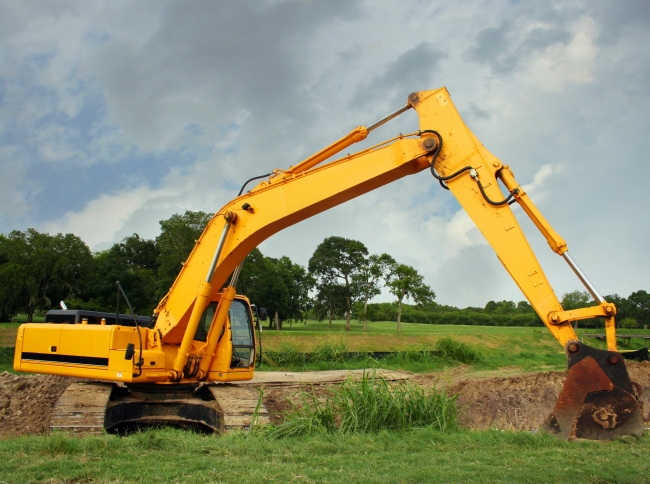
By Paul Seyfried and Sharon Packer (www.utahsheltersystems.com)
Tips to know when starting your fallout shelter …
Choose your underground (UG) site carefully.?? The first attribute for a good shelter location is an area with a low water table- that is, an area where you can dig a trench 18 to 20 feet deep without hitting ground water. ??In many areas, the water table can vary by seasonal rainfall (areas subject to hurricanes fall into this category).
Rocky Soil:
Rocky soil will work, but it can add time and expense to the excavation.?? The soil on our remote site is very rocky. ??We were taking out rocks the size of a small Volkswagen. ??Never back fill with large rocks. If you have solid rock you will need to blast (which is very expensive but doable).???? Gravely type soil is fine and drains well.
Wet Soil:
Wet soil of any kind, is a total non-starter. Spring excavations will show you the most likely ???high water??? level. For installations later in the year, carefully estimate the high water level of the soil.???? If you reach wet soil during excavation, back fill to a safe, dry soil level before installing the shelter. If you need more cover for warmth or radiation protection, mound the dirt to make a hill over the shelter.?? In areas of potential blast or high winds, make sure the slope of the mound does not exceed 30 degrees.
Hills & Valleys:
We would suggest that you look for an area that is not at the bottom of a vast slope. When placed in these locations, over a period of hours to days, the water that has collected over a shelter will super-saturate the soil and find any imperfection in the integrity of the shelter, and come inside. ??When a shelter is located up-slope, on high ground, the rain will run AWAY from the shelter and not saturate the soil deep underground (unless the soil is 100% sand). ??In short, high ground is good – low ground, not good.
We have built ???submarines???, where the entire shelter is below the water line, but they are welded plate shelters (steel fuel tanks), with solid steel pipe entrances. ??Submarine shelters must be held in place by heavy steel straps that are anchored into concrete.?? Steel plate shelters are heavy and harder to handle in the hole. ??A 48??? diameter entrance elbow made of corrugated pipe may weigh 250 pounds, where a 1/2 inch walled steel pipe entrance will weigh thousands of pounds. ??Water problems can be dealt with, but they increase costs, and the shelter components are more difficult to assemble on the job site. Keep in mind that wet soil and clay type soils do not ???arch??? and will compromise your blast protection.
Clay Soil:
Clay type soils hold water for a long time. ??When this type of soil is saturated, your underground structure is not only holding up the weight of the soil, but also of the water it holds. Clay soils are not even recommended for use against concrete foundations, as clay creeps and moves, and will eventually crack concrete walls.
In clay excavations, water will collect in and around the disturbed areas and the clay will hold the water, forming a ???swimming pool??? effect. Clay soils will require a good drainage system, such as a French drain.
Always consult a good soil engineer before installing your underground shelter. When installing in clay, soil Engineers often recommend that you totally remove the clay overburden, fill with crushed rock up to about 3 feet or so of grade and then apply engineer???s fill or road base for another couple of feet before applying a top soil layer.?? A layer of sediment screen over the crushed rock before the engineer???s fill goes in will protect your French drains from becoming clogged in the future.
We surveyed a shelter (not one of ours) that was buried in red clay soil in Virginia about six months ago, and it was near collapse when we looked at it. ??In addition to the clay soil present, the site was located in a large bowl- about 300 acres worth- so that all the rain in the world drained down to where the shelter was installed. Location, location, location! ??Parts of the shelter may possibly be saved if they remove the clay and replace it with engineer???s fill and crushed rock ??? something that will arch. The crushed rock will arch well, even when wet. ??Clay does not arch well, even when dry.
Deformation of Shelter:
Some deformation of the end caps/bulkheads in steel shelters is completely normal and expected. ??We know this will happen and we locate the bolt pattern holding the air handler brackets in a close, square pattern knowing that the strut will lift away from the end cap upon backfill. We plan for this when installing the deck (that???s why the deck does not contact the end caps) and the ventilation intake pipe. Corrugated pipe is not a particularly accurate cylinder, as it is wound in a spiral format, like a paper towel tube. ??Some deviation in the diameter dimensions is very normal. Most of them seem to come out a little larger on the ends than in the middle – but not always.
We recommend using a large track hoe (size 290 to 330) instead of a backhoe.?? The track hoe will get the job done much more quickly, and time is money.?? It also provides a huge safety factor when digging a deep installation.?? Never, ever, use a Bob Cat to back fill your shelter.
Pick your location carefully.?? Don???t be in a hurry.?? Dig a test hole and do a perk test. ??It will more than pay for its self in the long run???and NEVER back fill with clay.
